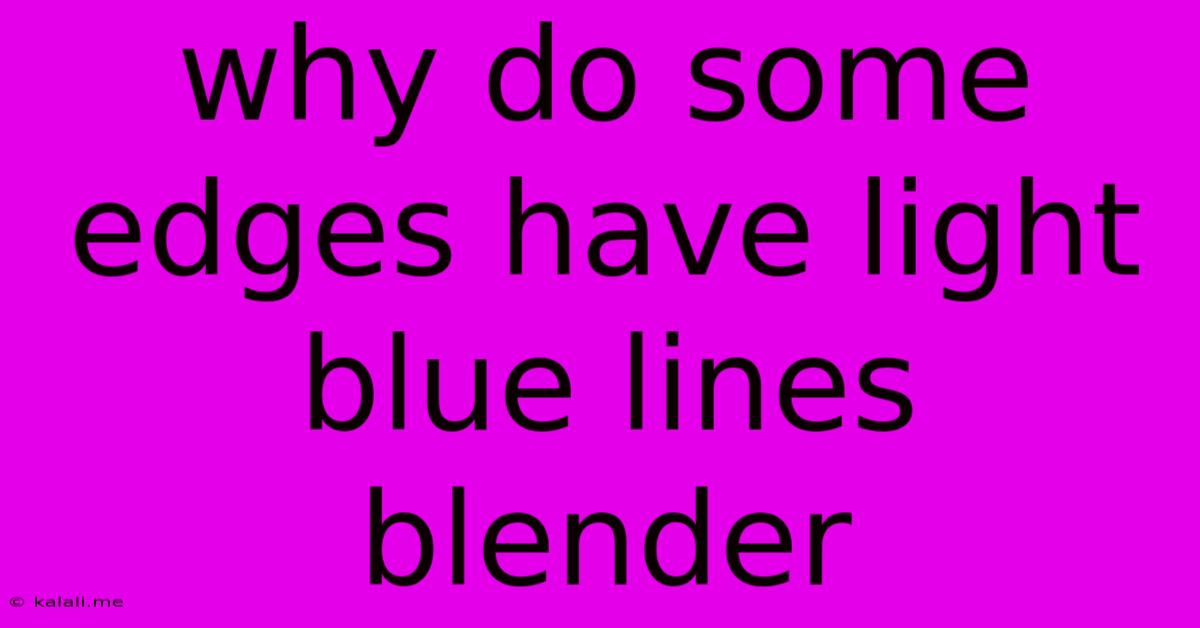Why Do Some Edges Have Light Blue Lines Blender
Kalali
May 23, 2025 · 3 min read

Table of Contents
Why Do Some Edges Have Light Blue Lines in Blender?
Blender's interface, while powerful, can sometimes be cryptic for newcomers. One common question revolves around those faint light blue lines appearing on certain edges in your 3D models. This article will explain what these lines signify and how to understand and utilize this Blender feature. These lines indicate edge selection modes and are crucial for efficient modeling and editing within the software.
Understanding these lines is fundamental to mastering Blender's edge selection capabilities. They represent a subtle yet powerful tool for precision in your 3D workflow.
What the Light Blue Lines Mean
Those light blue lines aren't a glitch; they're a visual representation of selected edges. Blender uses color-coding to help you visually track your selections, especially in complex models with numerous edges. A light blue line on an edge signifies that it's currently selected, and ready for manipulation. This allows for precise modifications, such as extrusion, beveling, or deleting specific edges without affecting the rest of the model.
Think of it as Blender's way of highlighting the edges you've chosen, making it clear what will be affected by your next action. This is particularly useful when working on intricate details or selecting specific edges for complex editing operations.
How Edge Selection Works
Selecting edges in Blender is straightforward but understanding the different modes is key:
- Single Edge Selection: Clicking on a single edge will select it, showing the light blue line.
- Loop Selection (Alt + RMB): Holding down Alt while right-clicking (or using the loop select tool) selects a loop of edges connected to your initial click. This is invaluable for selecting edge loops in organic modeling or selecting edges forming a continuous loop.
- Ring Selection (Ctrl + Alt + RMB): Similar to loop selection, but selects edges in a ring around the selected edge. This is ideal for working with edges around a circular or cylindrical shape.
- Box Selection (B): This allows you to select edges within a drawn rectangular boundary. This is efficient for selecting numerous edges within a certain area.
- Lasso Selection (C): Draw a freehand lasso to select edges within the enclosed area. Useful for complex selections that don't lend themselves to rectangular box selection.
Mastering these selection methods significantly improves your efficiency in Blender. The light blue lines provide immediate visual feedback ensuring you're working on the intended edges.
Troubleshooting and Further Exploration
If you're not seeing the light blue lines, make sure you're in Edit Mode (Tab key). This mode allows for direct manipulation of individual components of your 3D model, including edges. If you're still having trouble, check your Blender preferences – the color might be customizable, though the default light blue is widely used and recognized.
Furthermore, experimenting with these selection modes in conjunction with other Blender tools will unveil their true potential. Understanding how to efficiently select and manipulate edges is crucial for achieving precise and controlled edits in your 3D models, transforming your skills in 3D modeling and design. The light blue lines are just a small yet critical visual cue aiding in this process.
Latest Posts
Latest Posts
-
Can You Use Gps While Stranded In The Ocean
May 24, 2025
-
Wordpress Function To Reorganize The Admin Menu
May 24, 2025
-
How Long Do Metal Roofs Last
May 24, 2025
-
How Do You Say Have A Great Day In Spanish
May 24, 2025
-
How To Wire 3 Way Switch
May 24, 2025
Related Post
Thank you for visiting our website which covers about Why Do Some Edges Have Light Blue Lines Blender . We hope the information provided has been useful to you. Feel free to contact us if you have any questions or need further assistance. See you next time and don't miss to bookmark.